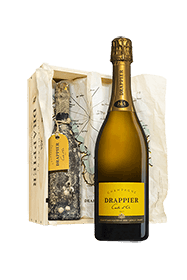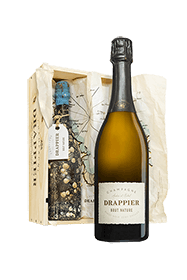Con orígenes que se remontan al siglo XVII, la familia Drappier es uno de los grandes nombres del Champagne. Desde 1808, la Maison Drappier encarna la excelencia vinícola de la Côte des Bar, donde el pinot noir reina con autoridad. Establecida en Urville, un pueblo cuya historia vitivinícola se remonta a la época galo-romana, esta propiedad familiar preserva un saber hacer transmitido durante ocho generaciones. La prestigiosa Maison cultiva una autenticidad hoy poco común: la de una familia de viticultores que posee y trabaja por sí misma sus 55 hectáreas de viñedo. Esta independencia les otorga la libertad de expresar una visión singular, en la que tradición y carácter se conjugan en armonía.
Champanes con carácter impulsados por el pinot noir
Las cuvées de Drappier se distinguen por su potente estructura y su profundidad aromática, fruto de un viñedo plantado en un 75% con pinot noir. La casa completa esta base con chardonnay, pinot meunier y variedades olvidadas como la arbane, el petit meslier o el fromenteau.
Carte d’Or, el emblema de la etiqueta amarilla
Creada en 1949, la cuvée Carte d’Or sigue siendo la firma de la propiedad. Su ensamblaje dominado por pinot noir le confiere un color dorado con reflejos cobrizos y una nariz expresiva de frutas amarillas maduras, brioche mantecosa y notas especiadas. En boca, el ataque es nítido y generoso, con una materia amplia y sedosa. Servir entre 8 y 10 °C con ave asada, quesos de pasta blanda o postres de frutas amarillas.
Brut Nature, la expresión pura
Verdadero manifiesto de la filosofía de la Maison, el Brut Nature sin azufre añadido encarna la autenticidad en estado puro. Elaborado sin dosaje ni sulfitos, revela con sinceridad la esencia de la fruta y la expresión del terruño. En nariz se muestra una mineralidad calcárea realzada por cítricos frescos y flores blancas. En boca, la vivacidad inicial da paso a una textura recta y tensa, de pureza cristalina, que se prolonga en un final salino y persistente. Servir entre 8 y 10 °C como aperitivo o con ostras, ceviche o mariscos yodados.
Charles de Gaulle, el homenaje histórico
Nacida en 1990 con motivo del cincuentenario del Llamamiento del 18 de junio, esta cuvée perpetúa el vínculo con el General, fiel amante de los champanes de Urville. Ensamblaje mayoritario de pinot noir con chardonnay, presenta un color oro pálido y burbuja fina. En nariz evoca frutas blancas confitadas, avellana tostada y un toque ahumado. En boca impresiona por su equilibrio entre potencia y elegancia.
Grande Sendrée, quintaesencia del saber hacer Drappier
Elaborada únicamente en las grandes añadas, Grande Sendrée representa la cima del saber hacer familiar. Procedente de una única parcela de 2,25 hectáreas, esta cuvée de añada expresa la quintaesencia del terruño calcáreo de Urville. Su complejidad aromática y su bella estructura la convierten en un champán gastronómico excepcional, con un potencial de guarda de 15 años o más. La versión rosé muestra una boca redonda y flexible, sostenida por una bonita tensión, donde se entrelazan notas de frutos rojos y naranja confitada.
Ocho generaciones al servicio de una visión
La historia de la Maison Drappier comienza en 1808, cuando François Drappier, antiguo leñador, adquiere 1,5 hectáreas de viñedo en Urville. Este terruño posee, sin embargo, una tradición vitivinícola milenaria: ya en época galo-romana se cultivaba la vid. En 1116, san Bernardo de Claraval introdujo el morillon noir, antepasado del pinot noir, y en 1152 los monjes cistercienses excavaron en la caliza las bodegas que aún hoy albergan las preciadas cuvées.
El punto de inflexión llegó en 1930, cuando Georges Collot tomó la audaz decisión de replantar masivamente el pinot noir, una variedad entonces totalmente ausente en la región. Hoy esta uva representa el 75% del viñedo de Urville. La Maison está actualmente dirigida por Michel y Sylvie, a quienes se unieron en 2016 sus tres hijos, Charline, Hugo y Antoine, que encarnan la octava generación de esta saga familiar.
Un terruño singular en la Côte des Bar
El viñedo se extiende por las laderas de Urville, en el Aube. Los suelos descansan sobre una base de creta kimmeridgiense, roca porosa y drenante que confiere a los vinos su mineralidad característica. Esta creta, idéntica a la de Chablis, explica la finura de los champanes producidos. Las parcelas se disponen en laderas orientadas al sureste, beneficiándose de una insolación óptima.
Más meridional que la Montagne de Reims, la zona de Urville disfruta de un clima ligeramente más cálido, favorable a la plena madurez del pinot noir. Los veranos soleados permiten alcanzar madureces elevadas, mientras que las noches frescas preservan la acidez natural. Esta combinación produce vinos potentes y equilibrados.
Champagne Drappier: un enfoque de mínima intervención
La conversión progresiva del viñedo a la agricultura ecológica demuestra la voluntad familiar de producir uvas sanas. En bodega, las intervenciones se reducen a lo estrictamente necesario: las fermentaciones se realizan con levaduras autóctonas, los dosajes son contenidos y el uso de azufre es limitado. Los vinos envejecen durante largo tiempo en las históricas bodegas del siglo XII, donde la temperatura constante favorece una evolución armoniosa.
La Maison Drappier encarna una visión singular del champán, la de una familia de viticultores arraigada a su terruño. La predominancia del pinot noir, el compromiso ecológico y las vinificaciones naturales dan lugar a cuvées con carácter que seducen a los aficionados en busca de autenticidad.





























